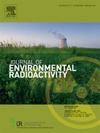The appropriate environmental sample to educate novice students in environmental radioactivity measurements using gamma ray spectroscopy
IF 2.1
3区 环境科学与生态学
Q3 ENVIRONMENTAL SCIENCES
引用次数: 0
Abstract
Proper implementation of gamma ray spectroscopy for environmental radioactivity measurements can often be challenging when trying to achieve high accuracy and high precision results. Phenomena such as gamma-ray self-attenuation can potentially add to the overall uncertainty in measurements, especially for samples that are large (100–500 g) and contain high-Z materials in significant quantities. As well, most environmental measurements need extended periods of time for measurements typically between 12 and 36 h per sample, depending on sample size and radioactivity concentration levels. For more than one decade we have been involved in radioactivity measurements in the oil and gas exploration sector, primarily in analyzing scale, soil and sludges. Our experience has revealed that scale is an environmental sample that can easily be analyzed for 226Ra, 228Ra and 210Pb in a relatively short period of time for only 20 g of material due to the unusually high concentrations of these radionuclides. All the daughter products that decay with gamma rays can also be readily measured. Because of the higher Z elements such as iron, barium and strontium in elevated concentrations, gamma ray self-attenuation is of paramount importance to elucidate, particularly for the 46.4 keV gamma ray belonging to 210Pb. And finally, there is a clear major disequilibrium in the 238U and 232Th chains. All these radiological and chemical characteristics for oil scale make this an ideal candidate to quickly teach novice researchers about the challenges in natural occurring radioactive materials (NORM) in gamma ray spectroscopy measurements. In addition, the number of researchers involved in environmental radioactivity measurements is decreasing and the need for an education template such as the one presented in this work is a very good tool for novice researchers in NORM.
适当的环境样本,以教育初学者在环境放射性测量使用伽马射线能谱。
当试图获得高精度和高精度的结果时,正确实施伽马射线能谱法进行环境放射性测量通常具有挑战性。伽马射线自衰减等现象可能会潜在地增加测量的总体不确定性,特别是对于大(100-500 g)且含有大量高z材料的样品。此外,大多数环境测量需要延长测量时间,根据样品大小和放射性浓度水平,每个样品通常在12至36小时之间。十多年来,我们一直从事石油和天然气勘探领域的放射性测量,主要是分析水垢、土壤和污泥。我们的经验表明,水垢是一种环境样品,由于这些放射性核素的浓度异常高,因此可以在相对较短的时间内轻松分析226Ra, 228Ra和210Pb,只有20g的材料。所有随伽马射线衰变的子产物也可以很容易地测量出来。由于高Z元素如铁、钡和锶的浓度升高,伽马射线的自衰减是至关重要的,特别是对属于210Pb的46.4 keV伽马射线。最后,在238U和232Th链上存在明显的主要不平衡。油垢的所有这些放射学和化学特性使其成为快速教授新手研究人员在伽马射线能谱测量中自然发生的放射性物质(NORM)挑战的理想候选者。此外,参与环境放射性测量的研究人员数量正在减少,需要一个教育模板,如本工作中提出的模板,是NORM新手研究人员的一个很好的工具。
本文章由计算机程序翻译,如有差异,请以英文原文为准。
求助全文
约1分钟内获得全文
求助全文
来源期刊

Journal of environmental radioactivity
环境科学-环境科学
CiteScore
4.70
自引率
13.00%
发文量
209
审稿时长
73 days
期刊介绍:
The Journal of Environmental Radioactivity provides a coherent international forum for publication of original research or review papers on any aspect of the occurrence of radioactivity in natural systems.
Relevant subject areas range from applications of environmental radionuclides as mechanistic or timescale tracers of natural processes to assessments of the radioecological or radiological effects of ambient radioactivity. Papers deal with naturally occurring nuclides or with those created and released by man through nuclear weapons manufacture and testing, energy production, fuel-cycle technology, etc. Reports on radioactivity in the oceans, sediments, rivers, lakes, groundwaters, soils, atmosphere and all divisions of the biosphere are welcomed, but these should not simply be of a monitoring nature unless the data are particularly innovative.
 求助内容:
求助内容: 应助结果提醒方式:
应助结果提醒方式:


